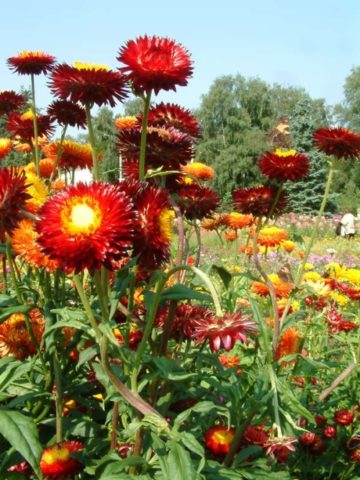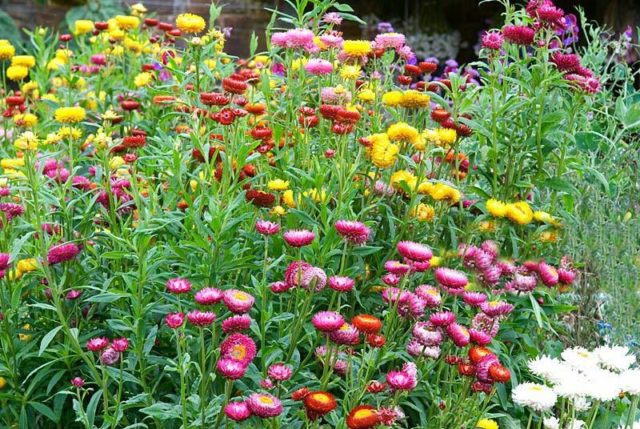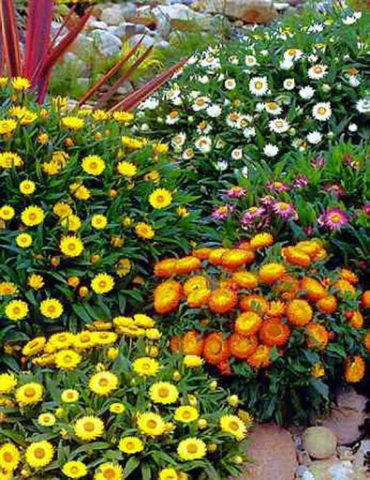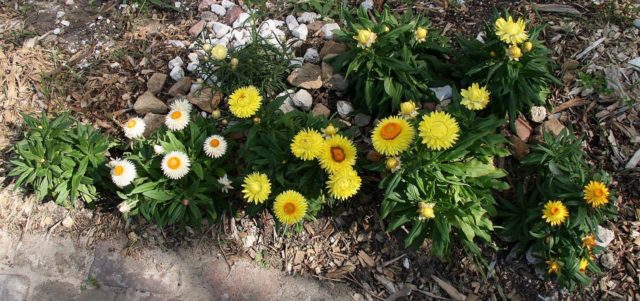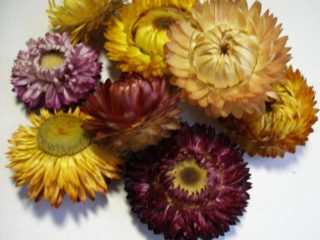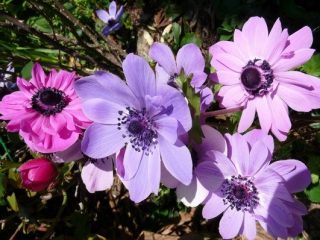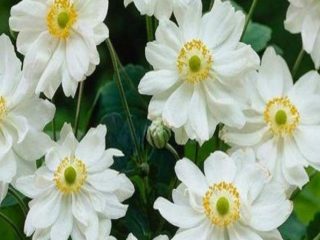Content
- 1 Description of gelichrizum
- 2 Types and varieties
- 2.1 Gelichrizum bracts
- 2.2 Gelikhrizum daisy-flowered
- 2.3 Gelikhrizum terry
- 2.4 Gelichrizum dwarf
- 2.5 Gelikhrizum petiolate
- 2.6 Gelikhrizum Selago
- 2.7 Helichrizum coral
- 2.8 Gelikhrizum narrow-leaved (silver)
- 2.9 Gelikhrizum ampelous
- 2.10 Gelichrizum arenarium
- 2.11 Helichrisum Milford
- 2.12 The best varieties of gelichrizum
- 3 Application in landscape design
- 4 Application of gelichrizum as a dried flower
- 5 Conclusion
In the photo of gelichrizum flowers, you can see a huge number of species and varieties with various colors of inflorescences - from white and yellow to rich red and purple. These are unpretentious plants that liven up every corner of the garden. They are able to retain their shape and color for a long time after cutting, so they are used as a dried flower to decorate winter bouquets.
Description of gelichrizum
Helichrysum is an annual or perennial herb from the Asteraceae family. The name translates as "golden sun", which is associated with the bright color of the flowers. It is also called Tsmin or immortelle because the flowers retain their shape and shade for a long time even after drying. The plant forms low, moderately spreading bushes. The stems are ribbed, can be either erect or creeping on the ground.
The leaves are arranged alternately. They are very narrow, lanceolate - about 1 cm wide, and from 3 to 7 cm long. They are painted in a rich dark green color, they can also be bluish or yellow (depending on the species and variety). The stems and foliage are covered with pubescence.
Inflorescences of bright color:
- pink;
- crimson;
- saturated red;
- yellow;
- orange;
- white.
Panicles or baskets in diameter reach 5-7 cm. In the center of the inflorescence, the flowers are tubular, and closer to the edges, they are tubular-filiform. Each flower consists of a center and wrapper leaves, which create the main background. The flowering period is very long: from the beginning of July to the first decade of October, when frosts come. After that, each peduncle produces dry fruit with small seeds.
Types and varieties
In the genus Gelikhrizum, there are more than 50 different species, of which 30 are cultivated in culture. In nature, they are common in the warm climate of Africa, Australia and Asia (tropical and subtropical zones). However, flower growers have bred several dozen varieties that are well adapted to the climatic conditions of the temperate zone, including in Russia. The most popular varieties of gelichrizum and photos of flowers in the garden will help in choosing a culture to decorate the territory.
Gelichrizum bracts
Helichrysum bracteatum (bracts) is a tall perennial plant, the upper shoots of which reach 75–80 cm. Leaves are typically lanceolate, dark green. Each peduncle has 6 tubular flowers, the color is white, orange, pink and bright red. Flowering lasts a very long time - from early July to the first half of October, and in the south - until November.

Gelichrizum bracts forms bright orange and red flowers that look good against a background of light green leaves
Gelikhrizum daisy-flowered
Helichrysum bellidioides comes from New Zealand. It is a stunted, ground cover plant (no more than 15 cm in height), giving many stems.Both leaves and shoots are covered with fluff, which gives them an interesting whitish hue. The lower leaves of this gelichrizum are larger than the upper ones (the length is 1–1.2 cm and 0.4–0.7 cm, respectively).
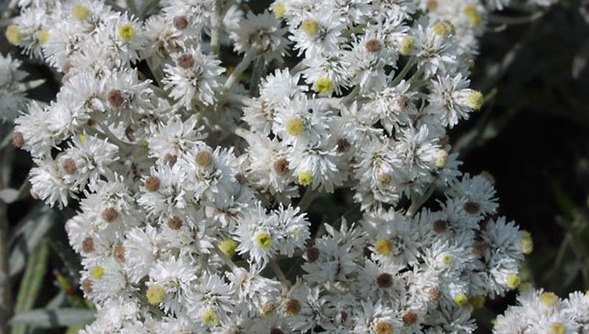
The daisy-flowered type of gelichrizum is distinguished by abundant flowering, it can be used to decorate nondescript places in the garden
The flowers are small - from 1.5 to 3 cm in diameter, have a silvery white tint.
Gelikhrizum terry
Terry gelichrizum Color mixture - a tall plant up to 100 cm. Each plant has up to 25 double flowers reaching 6–8 cm in diameter.
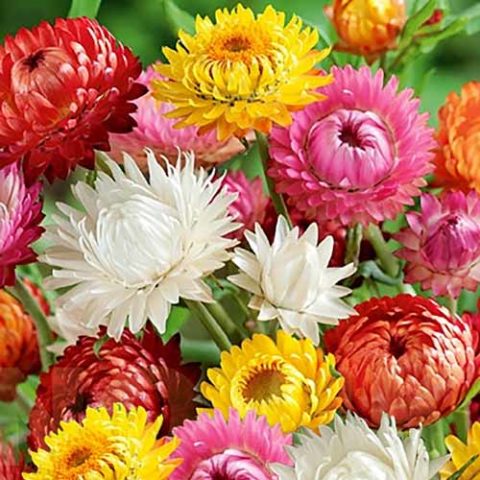
The color is varied - white, yellow, orange, red-brown, purple, pink
Due to this, it is used not only in garden decoration, but also as a dried flower for winter bouquets. The plant reproduces by seeds, which are planted in open ground in early summer (for seedlings - at the end of March).
Gelichrizum dwarf
Dwarf helihrizum (helihrizum dwarf) reaches a height of 30–40 cm, and a width of no more than 20 cm. The flowers are brightly colored. There are shades of yellow, orange, red and white. Suitable for cultivation on a private farm and on an industrial scale. One of the best dried flowers, retains color and shape for a long time. It is used to decorate flower beds and winter bouquets.
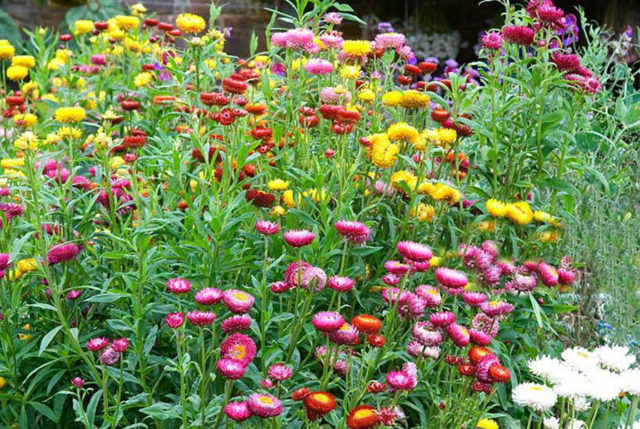
Dwarf gelikhrizum blooms in the year of planting
Gelikhrizum petiolate
This type of immortelle Helichrysum petiolare is one of the most popular among flower growers. And not because of the flowers (their color is not too bright), but because of the beautiful decorative foliage. The leaves are of an interesting oval shape, completely covered with a grayish cannon layer.
Shoots are creeping, high - up to 100 cm. They can hang from the pots, and also cling to a support, such as hops.

Pubescence gives gelichrisum an attractive silvery shade
They are taken out into the street only in summer, when the threat of return frosts has passed.
Gelikhrizum Selago
An annual creeping plant, Helichrysum Selago, forms small, dark green leaves. The surface is glossy, looks beautiful in the light. Inflorescences are formed at the tops, they are small, painted in light yellow tones.
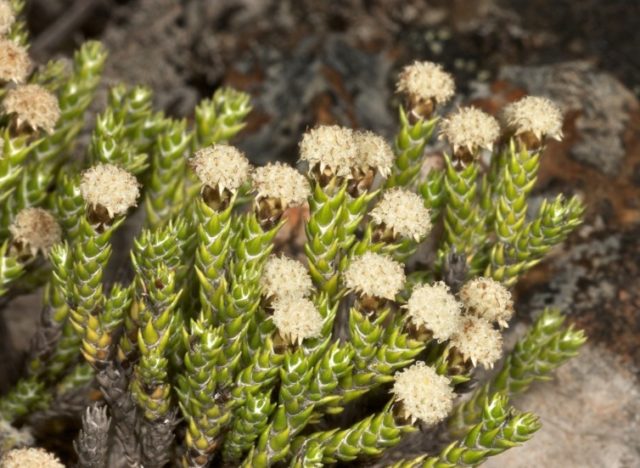
The flowers of the Selago gelichrizum are inconspicuous, but the foliage looks very unusual
Helichrizum coral
Helichrysum coralloides - originated from New Zealand. It is a dwarf bush with branched stems 20–25 cm high. The leaves are very small, there are so many of them that they resemble scales. The plant is unpretentious, grows on different types of soil and even on tuff (porous rock). The flowering is inconspicuous, the flowers are light yellow.
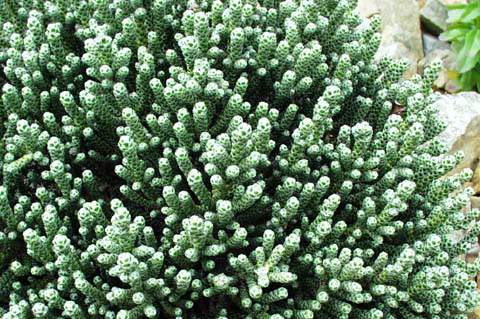
The bushes of coral gelichrizum reach the greatest decorative effect by the age of three
Gelikhrizum narrow-leaved (silver)
Another decorative type of immortelle is a shrub up to 60 cm high (about the same width). Silver gelichrizum has very narrow, numerous, silvery leaves. Feature of the variety - foliage gives a pleasant aroma The flowers are yellow, appear from July to the first half of September.
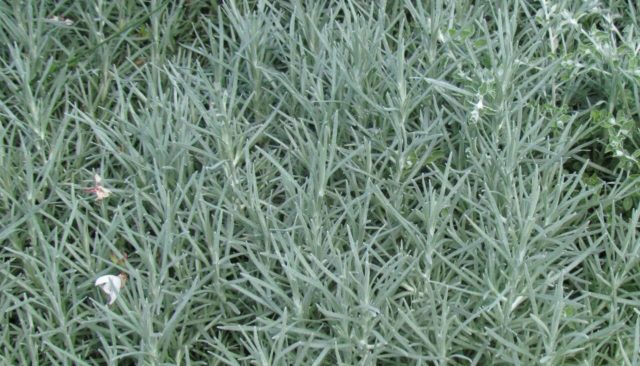
The narrow-leaved appearance is decorative due to the numerous narrow leaves of a silvery shade
Gelikhrizum ampelous

Ampel gelichrizum (ampelous) is one of the most popular species that flower growers prefer to grow in hanging pots, and only take out to the street in summer
Flowers are collected in umbrellas, and appear only on the tops of the shoots. They grow evenly, thanks to which a ring with bright flowers and interesting foliage hangs around the pot.
Gelichrizum arenarium
Variety Helichrysum arenarium is low - erect stem grows up to 35–40 cm. Leaves are small in size - 2–6 cm long.Inflorescences are spherical baskets with yellow or orange flowers (10-30 per plant).
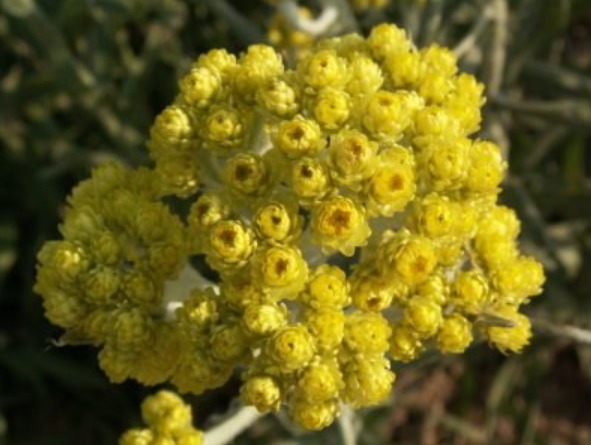
Inflorescences of gelichrizum arenarium completely dot the small bush
Helichrisum Milford
One of the most beautiful flowers of Helichrysum Milfordiae. Inflorescences consist of 2 parts - inner (white) and outer (deep pink). Unlike most species and varieties, it begins to bloom as early as May (the end of the period is in July).
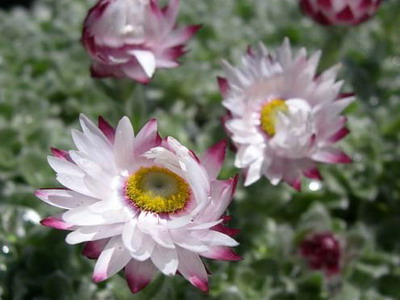
Milford immortelle flowers look great in bouquets
The best varieties of gelichrizum
Almost all cultivars and types of gelichrizum are highly decorative due to the bright, numerous flowers or attractive leaves of an unusual silvery shade. The most interesting varieties are used to decorate the garden and make bouquets.
King size
Gelichrysum King size (Helichrysum bracteatum Korolevskiy razmer) produces large bushes 80–100 cm high, provided that there is abundant watering. Flowering begins in July and ends in October. The inflorescences are also large - these are graceful baskets with a diameter of 7-8 cm.
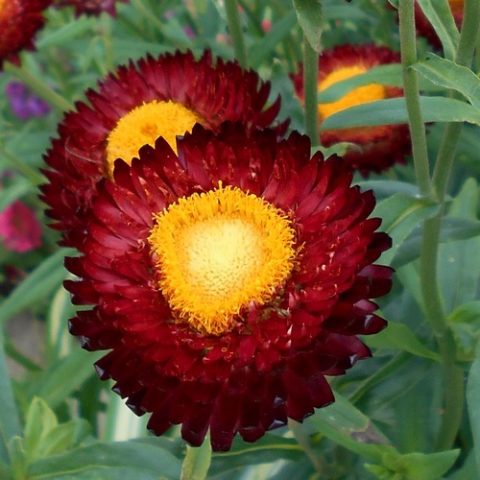
Coloring variety King size rich red, raspberry, beetroot
Silver rose
Gelikhrizum Silver rose has a very unusual color. The inflorescences of this immortelle have a delicate peach shade, partly pearlescent, they look beautiful in the sun. The bush reaches a height of 90 cm, the diameter of the flowers is 7–8 cm. The plant loves open, sunny places. The bush is not very sprawling, so when planting, you can leave an interval of 25-30 cm.

Silver rose is one of the most beautiful varieties of immortelle
Swiss giant
Gelichrizum The swiss giant has the trade name "bright set". This is an assortment of bright red, pink, yellow, orange inflorescences. Bushes are high - up to 100 cm, prefer open sunny areas. Thanks to such a palette of colors, the flower is suitable for any flower bed, it is also used as a dried flower for composing compositions.
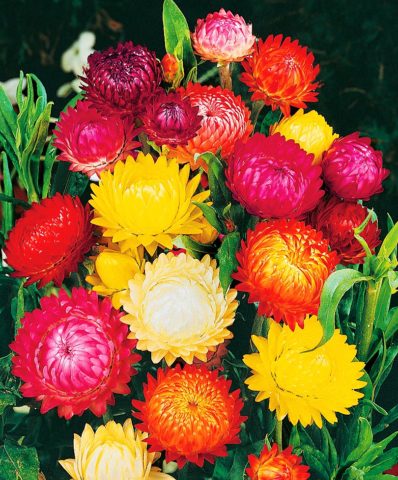
Gelichrizum The Swiss giant allows you to create a flower bed for every taste
Pink porcelain
Pink porcelain is a graceful dwarf shrub no more than 20 cm high. The plant produces numerous creeping shoots. It begins to bloom from mid-July before the onset of the first frost. In the reviews, flower growers describe Gelichrizum Pink porcelain (pictured) as an interesting, lush flower of a pale pink hue. The inflorescences are graceful, about 2.5–3 cm in diameter. Pink porcelain is a thermophilic plant, so you need to grow it at home, although in summer you can take it out on a balcony or terrace. Looks especially beautiful in a flower pot. Pink porcelain will appeal to lovers of delicate pastel colors

Pink porcelain is a thermophilic plant, so you need to grow it at home, although in summer you can take it out to a balcony or terrace
Byzantium
Gelikhrizum Byzantium (vizantiya) a mixture of seeds - a kind of immortelle with medium-sized, moderately spreading bushes from 60 to 80 cm high. Inflorescences of bright color: white, yellow, pink, red, orange. Abundant flowering, lasts from July to late September. For planting, flower beds are chosen in open, sunny areas. The immortelle of this variety is used to create a beautiful landscape design, as well as cut (as a dried flower).

Byzantium is an annual plant that is grown in seedlings.
Silver Mist
Helichrysum Silver Mist is rightly considered one of the best varieties. Leaves with an unusual velvety texture. They are distinguished by their small graceful size and oval shape. The foliage has a silver tint and looks beautiful anywhere in the garden. The bush does not need to be pinched and cut, it does not grow very quickly, but evenly. As a result, adult helihrizums of this variety grow up to 20 cm in height, and spread up to 40-50 and even 60 cm wide.
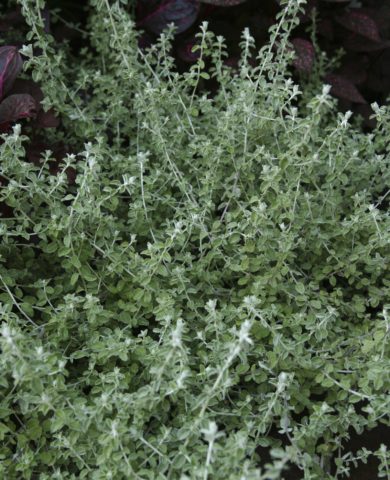
Gelichrizum Silver Mist is decorative throughout the season thanks to its attractive silvery foliage.
White sun
The variety White sun is distinguished by very large flowers (7–10 cm in diameter) of snow-white color. The bushes are quite large, reaching a height of 90 cm. They look good in single plantings, as well as in combination with the Silver Rose immortelle. The inflorescences can be used for dried flowers: in this case, they should be cut off at the moment when they are only half blooming. When planting, leave an interval of 30–40 cm - the greater the distance, the more spreading the bush and the more luxuriant the flowering.
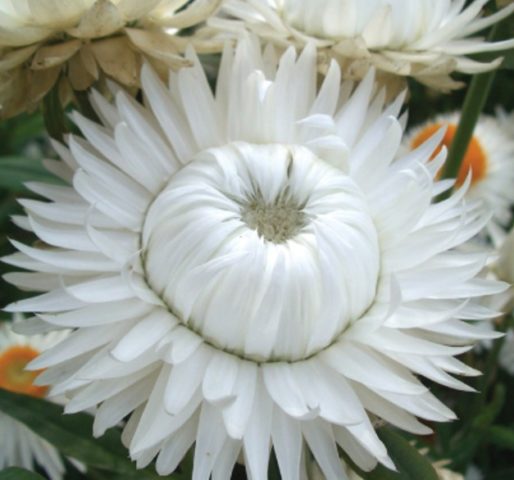
Large flowers of the immortelle White sun will enliven any corner of the garden
Violet
Violet is a large shrub that grows up to 100-110 cm. Inflorescences are purple, red, burgundy, with bluish tints. They look very bright and attractive; diameter of inflorescences 4-6 cm. Appear from the beginning of July to the first half of September.
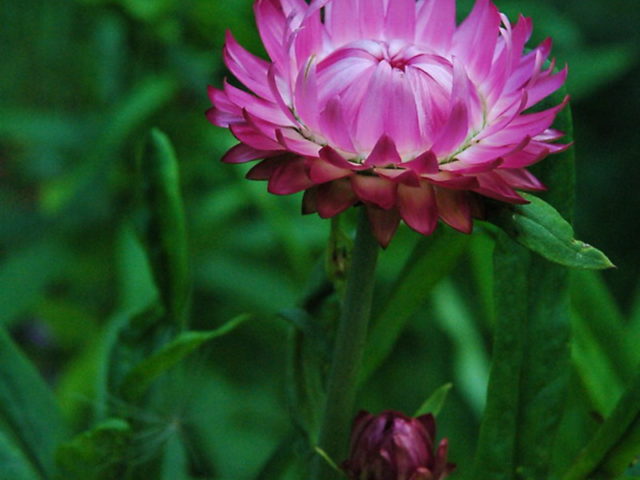
Violet is one of the most beautiful types of gelichrizum, combined with many colors
Yellow
Helichrysum Yellow is a variety of Helichrysum bracts. Gives quite large bushes 95-105 cm high. Flowers are rich yellow (like sunflower petals), 5-6 cm in diameter, appear from the last decade of June to early September.
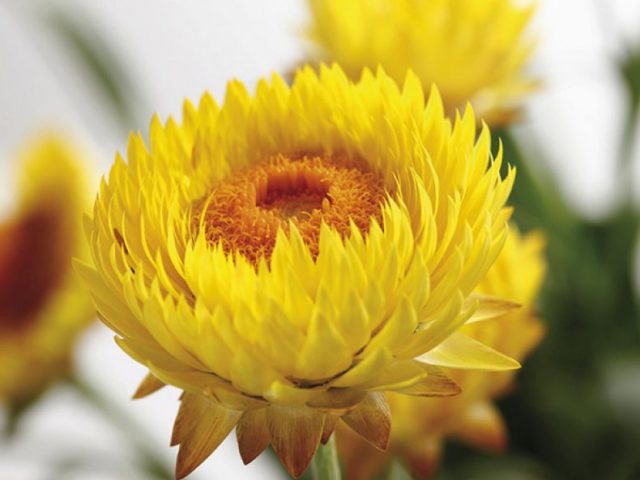
Yellow is a classic unicolor variety that can be used both in single plantings and in compositions.
Bright yellow flowers look good in flower beds and flower beds.
Application in landscape design
Gelikhrizum is unpretentious in care. The culture produces a large selection of brightly colored flowers. Therefore, the flower has become very popular among experienced and novice florists. Plants are planted in flower beds, ridges, used in single plantings and mixborders. Seedlings can be placed in pots and planters on the terrace and garden.
They can be combined with almost any color - you just need to take into account the size ratio. Often, helihrizum is planted next to such plants: lobelia, shaved, rezuha and others.
Below are several options for using gelichrizum flowers in a flower bed with a photo and description:
- Single landing.
- Composition of different varieties.
- Mixborder.
- Ground cover.
- Solitary planting option.
Application of gelichrizum as a dried flower
Almost all cultivated species and varieties of Gelichrizum have the ability to maintain the color and shape of inflorescences for a long time. Therefore, they are used not only to create beautiful compositions in the garden, but also as a dried flower for composing winter bouquets.
For these purposes, the inflorescences begin to be harvested in August, until the moment when they begin to fade. It is recommended to take flowers that have recently opened and have not yet fully blossomed. It should also be noted that the inflorescences should not have any defects. Even the smallest damage caused by drying will be much larger, so this dried flower won't last long.
Another important point is that it is better to collect inflorescences from plants that bloom in the first season (annuals or young perennials). It is they who will stand the longest. They start harvesting in July or August. At the same time, the weather should be warm, without rains and strong winds. The peduncles are cut using ordinary scissors or a sharp knife. Then proceed to drying gelichrizum. Do not do this in the sun, as the petals will lose color.
Experienced flower growers dry inflorescences in three ways:
- On open air.
- In sand.
- In cotton wool.
In the first case, the baskets are carefully planted on a wire, and then hung with flowers down on a terrace or other open space (under a canopy). The dried flowers will be ready in 20-25 days. If it is humid outside, it rains constantly, it is better to bring them into a room with a high air temperature (for example, to the kitchen) and hang them from the ceiling.
Drying in sand is easier, therefore it is used more often. To do this, a layer of sand of 8–10 cm is poured into the container and the peduncles are placed with inflorescences upward, leaving small distances between them (that is, they are simply stuck into the sand, as into the soil).Leave in the room for several days, then cover the inflorescences themselves with sand for a month. The resulting dried flowers will retain their shape and color for a whole year.
For drying with cotton wool, take a sheet of cardboard, make several holes at a distance of 8–10 cm and thread the stems into them. A layer of cotton wool is placed on the cardboard, where the inflorescences are placed, and the second layer goes on top. The structure is covered with another sheet and tied together. Suspended from the ceiling and left for a month in a warm room.
Conclusion
Photos of Helichrizum flowers show all the variety of colors of these plants. Florists can use almost any species and varieties - the choice is limited only by winter hardiness. When creating a flower bed, it should be located in an open, sunny area, protected from strong winds.
